Carp Streamers, Samurai Armor and Iris Leaves - Boys' Day Festival in Japan
While Japan officially designates May 5 as Children's Day, Japanese families tend to focus more on the traditional Tango no Sekku, the Boys' Day Festival.
by Bob Kerstetter
You receive a windsock as a gift from a Japanese friend you host during a cultural exchange program. A large green fish stretches from mouth to tail along the streamer as it ripples in the breeze. You enjoy watching the windsock continually reshape itself, conforming with the natural movements of air.
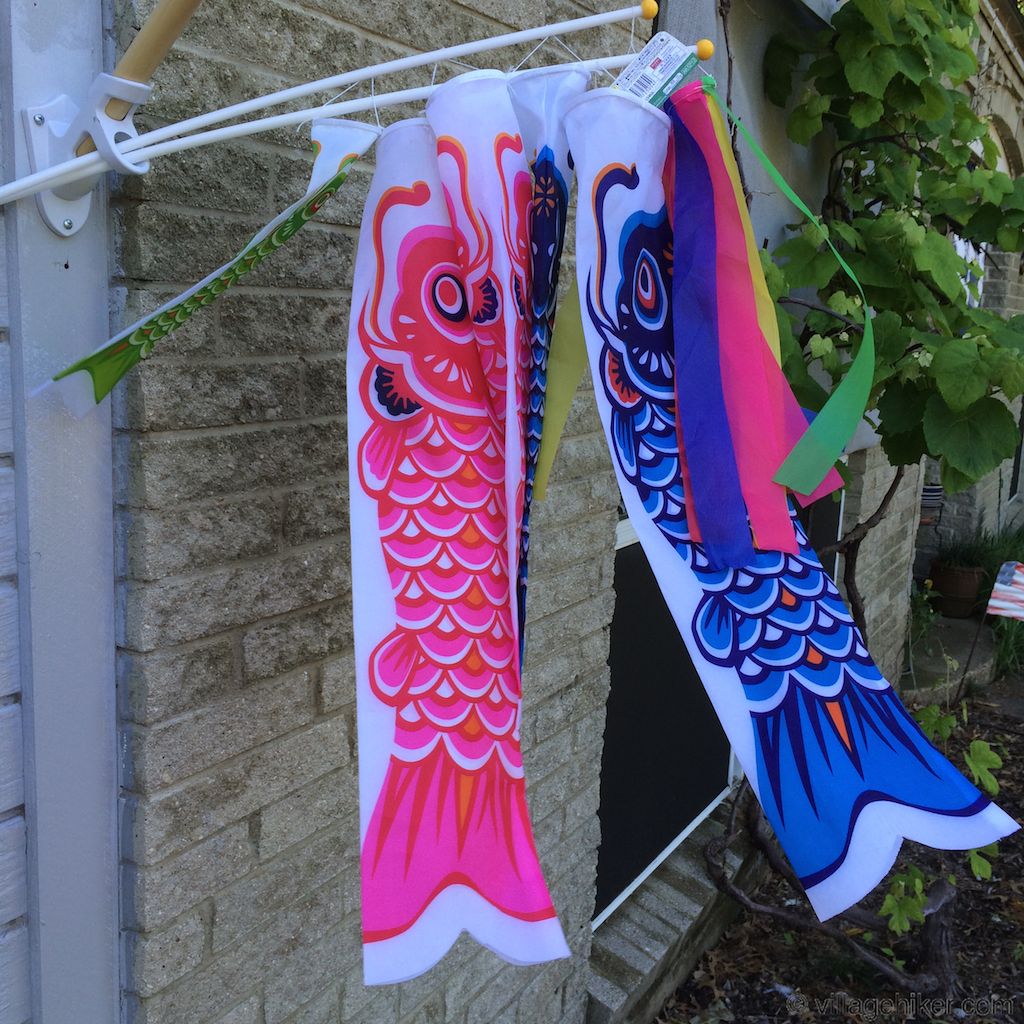
Two koinobori hang outside an American home in Texas. They came from a Daiso 100 yen store in Hiroshima.
Seeking Fish Windsocks
Years later in Hiroshima you enter a Daiso—a 100 yen store comparable to a dollar store. You seek windsocks to carry home as gifts. A store employee pleasantly smiles with a quizzical look on her face when you ask for fish windsocks. "Fukinagashi no sakana ari masu ka," you ask, hoping it means something akin to "Do you have fish windsocks?"
She possibly understands. After several minutes of shadowing you throughout the store as you point to flags, wave socks in the air and make fish faces, her eyes brighten.
"Chotto matte kudasai," she says, holding her righthand palm out before scampering down the aisle and disappearing through a door. You assume it leads to the store stockroom. Her words translate as "Just a moment please."
While you somewhat expect to never again see her—and perfectly understand why—she returns in a few minutes carrying a half dozen fish windsocks of various sizes, priced at more or less 100 yen each.
"Koinobori desu," she says, smiling. Looking this up you see it means "this is a carp flag" or something very close. She says, "This is all we have. The festival is past."
For her trouble, you buy all six, thanking her multiple times and bowing more often than necessary. "What festival is past?" you wonder as you walk along the street.
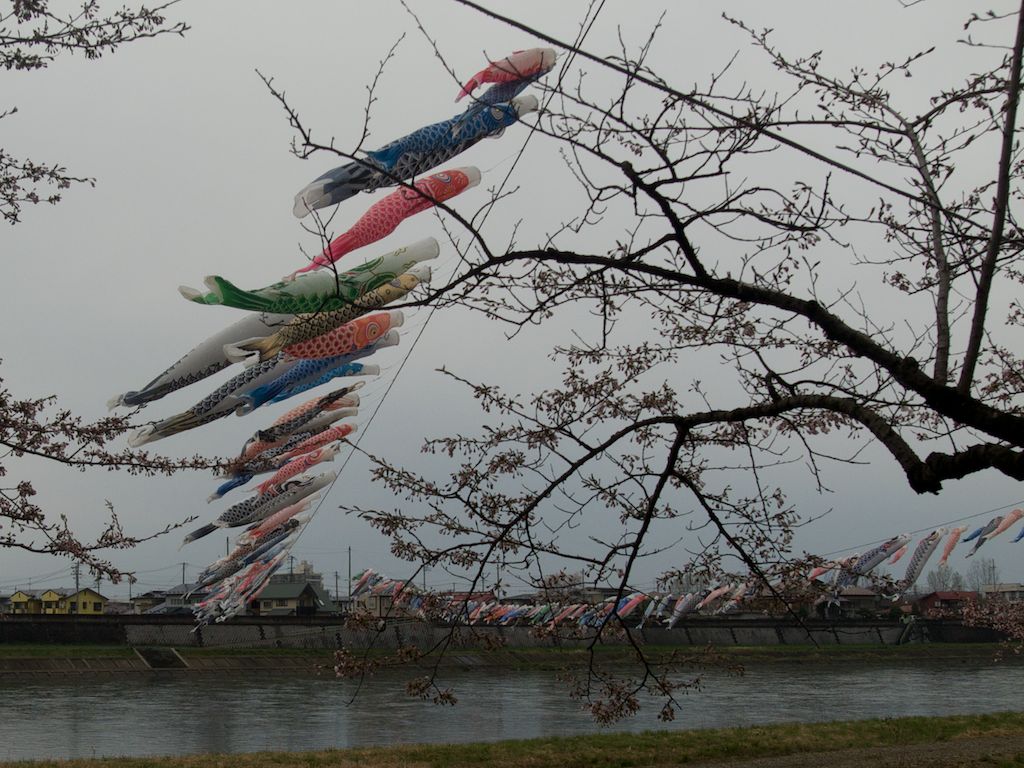
With cherry trees in the foreground for size comparison, two rows of koinobori span the Kitakami River in Tenshochi Park, Kita City, Iwate Prefecture, Japan. Many cities raise koinobori in public places in the weeks leading up to the Boys' Day Festival—Tango no Sekku—May 5.
Discovering Giant Koinobori
Eight months later and back in Japan, you exit the Shinkansen—the bullet train—in Kitakami City, about 500 kilometers north of central Tokyo by rail. The wind blows steady and light toward the south on this cool, damp and cloudy afternoon. Looking for cherry blossoms in late April, you arrive a few days too early. You find plum blossoms, cherry blossom buds and carp flags—koinobori—lots of them and very large. Two rows of giant carp streamers gently float from cables spanning the Kitakami River. The sight surprises you.
"Koinobori celebrate the Japanese boy," says a woman working at Kitakami Train Station. "They represent strength, plus wishes for good health, courage and successful living. In Japan we also celebrate the Japanese girl on March 3, but in a different way."
Carp streamers symbolize the determination of fish swimming upstream, struggling toward their goals. According to Japanese tradition, carp fight the currents, ascend a waterfall and receive rewards for their courage and endurance. Atop the final cascade, they transform into dragons and fly away into the sky. Contrary to their western coequals, Asian dragons typically view people as possible companions, allies and friends, rather than as edibles.
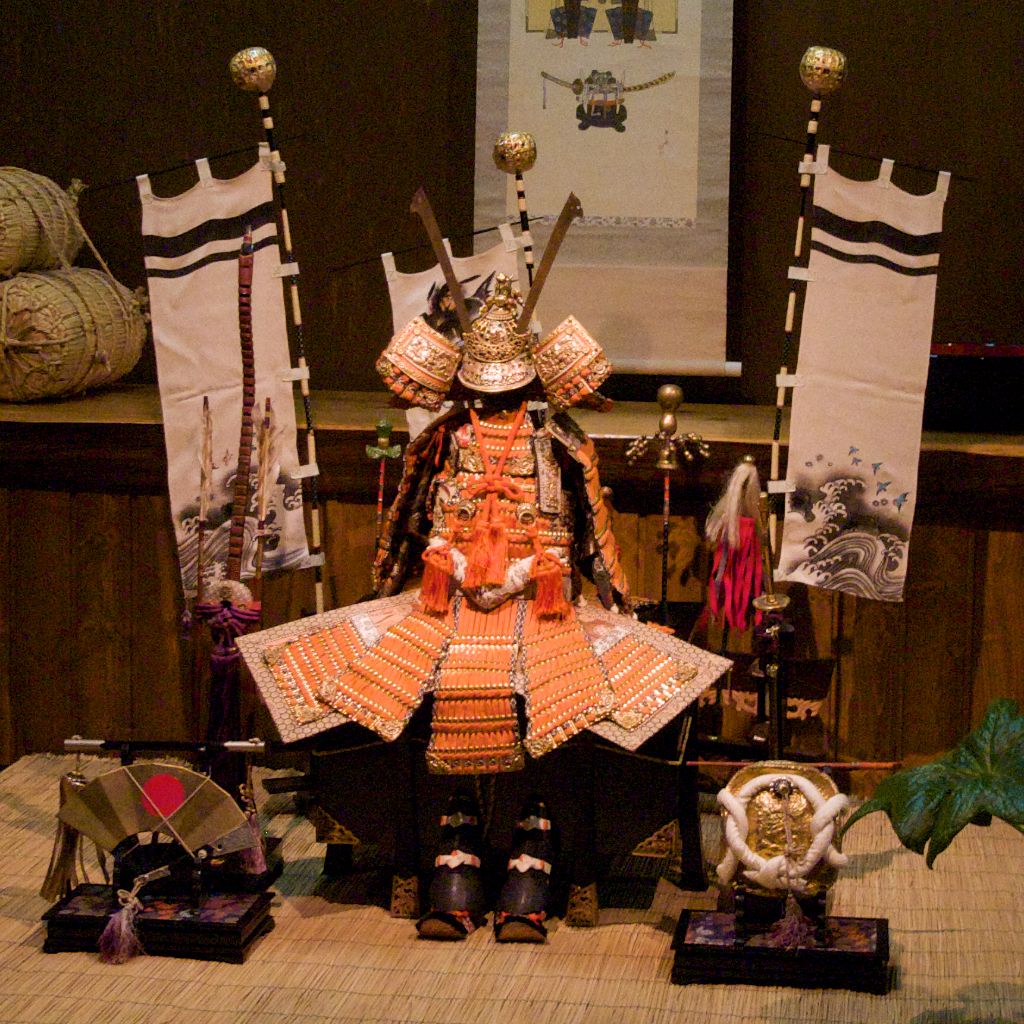
While traditional May Dolls emphasized samurai and legendary heroes, gogatsuning now accentuate the historical and contemporary artistry of samurai helmets and armor.
Learning About Tango No Sekku
Many Japanese families fly koinobori outside their homes during the weeks leading up to Tango No Sekku—the Boys' Day Festival—celebrated May 5 annually throughout all of Japan. Parents also fly koinobori at other times to announce to their neighbors and heaven the birth of a son. They fly two koinobori to proclaim the arrival of twin boys, three for triplets and—you get the idea.
During the Boys' Day Festival, families elevate one flag for each boy in their homes. They may also fly a black koinobori for the father and a red one for the mother. The cost of flags can become very expensive. Limited space makes them cumbersome to fly. Because of this, some Japanese cities raise multiple koinobori in public places to represent all boys and their families within their communities.
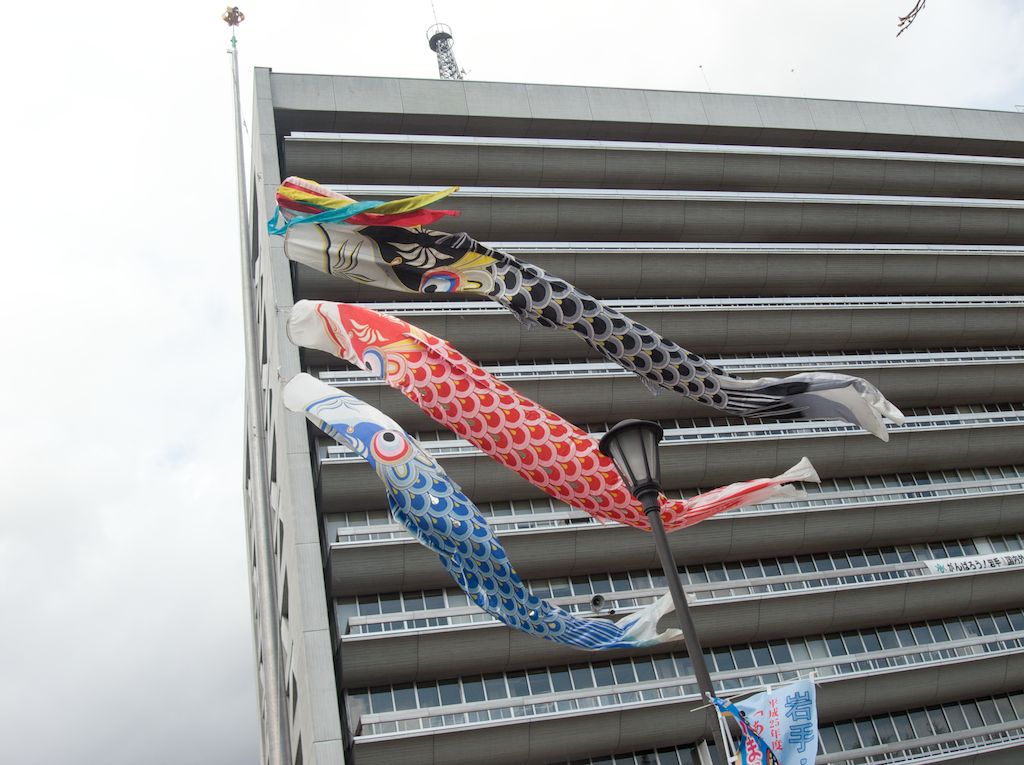
Because the flag pole sits out from the Iwate Prefecture Building in Morioka, Japan, you could view this as a fish story. But these carp streamers—koinobori—really do stretch multiple meters in length. One meter measures slightly longer than a USA yard stick.
Observing May Dolls in Iwatsuki
A few days after leaving Kitakami City and its carp flags, you catch a local train in the Akihabara district of Tokyo, change trains twice and arrive in Iwatsuki. Located on the road between Tokyo and Nikko Toshogu Shrine, Iwatsuki became famous when the craftsmen rebuilding the shrine for the Tokugawa Shogunate noticed the dolls. Wanting to be part of this art, many of the shrine-builders later settled here. At Iwatsuki Station you stand within walking distance of 300 doll-making workshops, employing about 3,000 artisans.
Important to Tango no Sekku, the doll makers of Iwatsuki create May Dolls or Gogatsuningyou. Families display these during the festival to encourage their boys toward bravery, skill and persistence, plus good health and success. While at one time, the May Dolls honored famous samurai and traditional heroes—you can still find such dolls in Iwatsuki—the dolls of today emphasize the artistry of samurai helmets and armor.
In Iwatsuki you also find hina for the March 3 celebration of Japanese girls, Hina Matsuri. Hina honor the traditional imperial family by representing the emperor, empress, ladies in waiting, chancellors and vassals.
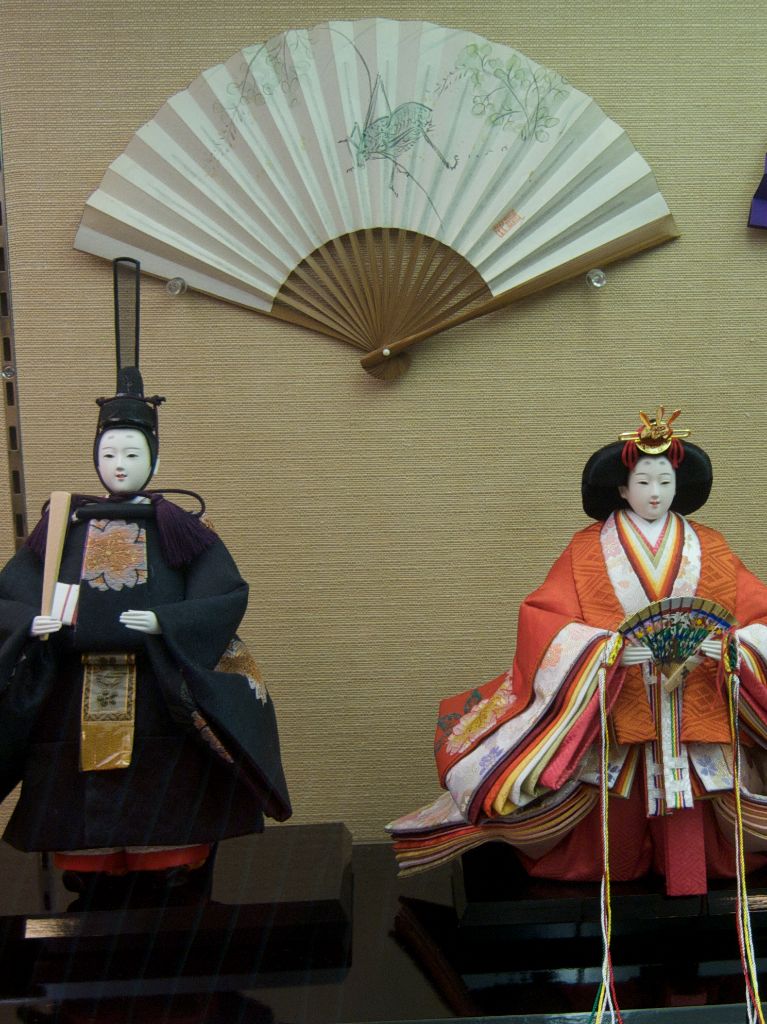
You can see Hina Dolls throughout Japan. These reside at the Edo Shitamachi Traditional Crafts Museum in Tokyo.
Extending a Samurai Tradition
Tango no Sekku originated from the practice of samurai families celebrating and encouraging their sons. Common people soon emulated the practice. In addition to flying carp streamers and setting out May Dolls, families hang iris leaves under the eaves of their houses. Individuals also bathe in water steeped with iris leaves and eat seasonal foods. All these activities aim to expunge evil and build up Japanese boys.
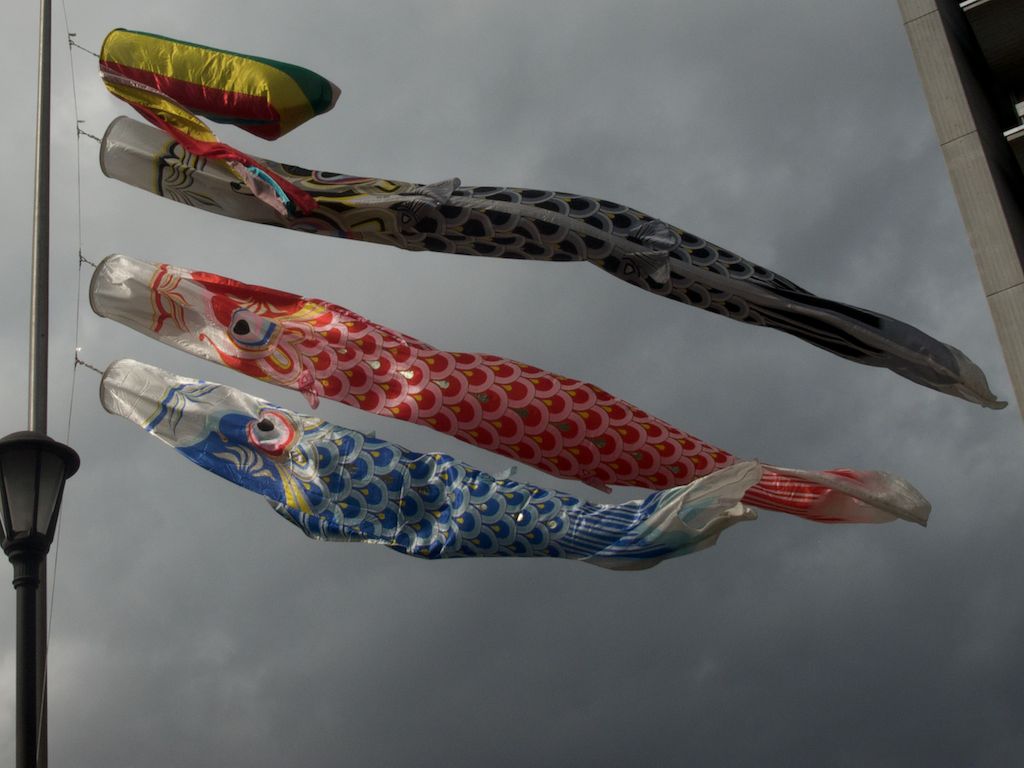
Large and colorful carp streamers—koinobori—move with the wind in Morioka City, the capital of Iwate Prefecture on the Japanese island of Honshu. They symbolize carp swimming upstream and celebrate the boys of Japan.
Acknowledging Children's Day
While Japan officially designates May 5 as Children's Day, Japanese families tend to observe the traditional Hina Matsuri on March 3 and Tango no Sekku on May 5.
Japanese Word — Pronunciation — English Translation
端午の節句, たんごのせっく — Tango no Sekku— Boys' Day
鯉のぼり, こいのぼり — Koinobori — Carp Flag
五月人形, ごがつにんぎょう — Gogatsu Ningyou (gogatsuningyou) — Boy's Day Dolls
雛祭, 雛祭り, ひな祭り, ひなまつり — Hina Matsuri — Girls' Day, Doll Day